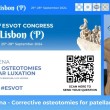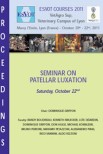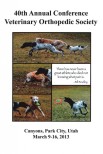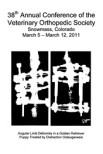
Q1. You have published material regarding Fractures of the Feline Patella. Statistically that is not a very commonly reported injury. Or do you think that is often missed, due to the natural reserve of cats when they have been injured and particularly outdoor cats?
In a similar situation to osteoarthritis in cats, which is much more common than one would have been led to believe clinically, I think patella fractures (originally termed bipartite patella), if looked for, will also be more common. This condition can be picked up as an incidental finding.
Q2. Do you consider that the development of the cat’s patella is little understood and just believe that it develop from only one Centre of Ossification?
That is an interesting question and given the commonest fracture configuration is transverse in the mid to proximal third and some minimally displaced fractures are seen in very young cats and kittens it could be possible that the bone develops from two separate centres of ossification. Looking histologically or radiographically at the patella of some kittens might help answer this question?
S. I think further questions could lead into other conditions of the F.P that you have studied etc.
The presence of other avulsion type or low energy shear fractures, such as humeral condylar fractures, acetabular fractures and also retained deciduous teeth in cats with patella fractures does lead me to believe there is an underlying problem in some, but not necessarily, all cats with patella fracture. I have a paper due for publication in the Veterinary Record where ten cats, all with old incidental and mainly bilateral patella fractures, presented with unusual proximal transverse tibial fractures. These cats had evidence of remodelling of the cranial tibial cortex prior to fracture, a feature of a stress fracture. Minimally displaced stress fractures of the acetabulum have also been reported in greyhounds. I am collecting samples of skin from cats affected with patella fractures to analyse collagen in order to investigate the possibility of an underlying abnormality, such as an osteogenesis imperfecta, as a first line of enquiry. The presence of retained deciduous teeth in some of these cats is interesting to me – dentinogenesis imperfecta is seen in some cases of human osteogenesis imperfecta. I could not find any figures for how common retained deciduous teeth are in cats generally? It is a fascinating topic with a lot of un answered questions and I will be very pleased to hear from veterinarians with cases so I can continue my research on feline patella fractures.















